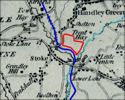|
|
|
David Prodlove's
critique of the built environment of Stoke-on-Trent
|
‘Welcome to Stoke-on-Trent’ |
![]()
![]()
next:
‘In Praise of Father
Ryan’ -Church of the
Sacred Heart, Tunstall

click for more on
Winton Square
|
There is much talk today about urban design and
creating great places, and a higher demand for truly great architecture
and design. Pick up ‘vision’ documents produced by local authorities and
regeneration agencies, and without fail they will talk about ‘gateways’,
and ‘landmarks’.
Well, Stoke-on-Trent possesses one of the finest gateways in the country in Winton Square; step off the train in Stoke-on-Trent and you are met with one of the finest examples of Victorian urban planning you are likely to come across, and two great landmarks in Stoke-on-Trent Railway Station and the North Stafford Hotel, both of which are Grade II* Listed.
Stoke-on-Trent Railway Station Laid out in 1847 and completed in 1848 by H. A. Hunt for the North Staffordshire Railway Company (or ‘the Knotty’ as it was known), the area was at the height of rail mania. Indeed, at one point – including local mineral lines – North Staffordshire had the densest local rail network in Europe. What would the region give for this now, in these days of mass car ownership and environment strangling congestion?
Built in brick and sandstone to a beautifully
detailed Elizabethan and Jacobean design, such an approach was a common
theme across all of the railway company’s main stations (another excellent
local example being Stone Railway Station), with the clear intention of
making a major statement on behalf of themselves, and the area. Recently I had an interesting discussion with an architect from a large, well-known practice around how public spaces worked, and asked him if he knew Winton Square and Stoke-on-Trent Railway Station. His response was “when I arrive in Stoke-on-Trent, I normally close my eyes”. The fool; you can only learn with your eyes open, and this would be great learning material for any aspiring, or indeed, experienced designer.
North Stafford Hotel
|
on the history of Stoke
take a 'walk' around Stoke Fields & Winton Wood
on the statue of Josiah Wedgwood outside the north Stafford Hotel
next: ‘In Praise of Father Ryan’ -Church of the Sacred Heart, Tunstall